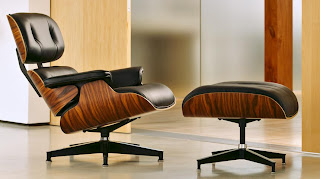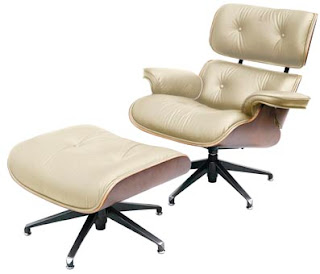The Eames lounge and ottoman was one of the first Eames chairs to be designed for the high-end furniture market. They were constructed of three curved plywood shells and leather seat cushions. The Eames chair was publicly introduced in a 1956 television show and was made famous by a Herman Miller advertising campaign which touted the versatility of the chair by showing it in a Victorian parlor, on a rural front porch, and in the middle of a sunny hayfield. The lounge and ottoman are still in production today, 54 years later, both by licensed companies and as knock-offs by Chinese and European manufacturers. Herman Miller and Vitra are the only companies licensed to use the Eames name.
The original chairs are highly collectible. They were produced with a Brazilian Rosewood veneer, which is no longer available. This is one way in which original models are identified. In 2006 a special production run of the chair was released which used Palisander Rosewood veneer, in commemoration of the 50th anniversary of the original release.
Rosewoods are a species of small to medium-size trees and shrubs in the pea family. They are native to the tropical regions of Central and South America, Africa, Madagascar and parts of southern Asia. Rosewood is valuable because it has decorative and fragrant wood. The wood is rich in aromatic oils and smells like roses. Brazilian Rosewood was heavily exploited in the past and is no longer commercially used. It is protected by the Convention on International Trade in Endangered Species of Wild Fauna and Flora (CITES). The Palisander Rosewood used in the 2006 Herman Miller production run is also known as Madagascar Rosewood. It is a sustainable product, not endangered, and is used primarily for the production of guitars.
The Eames leather ottoman doesn’t receive nearly the same amount of publicity as the lounge, but it is an integral part of the furniture. While you can frequently find Eames chairs for sale on the second-hand market, they often are not accompanied by the matching ottoman. New chairs and ottomans sell for around $3,000. This is in part because of the comfort of the chair, but is mostly because the furniture is seen as a symbol of status. The early chair/ottoman sets are highly collectible, and an original production with Brazilian Rosewood can bring as high as $7,000 at auction.
If it is not the status, but simply the comfort that is desired, then many chairs “inspired by” the original design are available at much less expensive prices, ranging from $250 to $400. Most of these products seek to associate themselves with the Eames name, but are careful to call themselves “Eames inspired.” If the advertisement blurs the line of trademark law and makes it difficult for you to determine whether you are buying a knock-off or an extremely cheap Eames chair, steer clear of the sale.




















0 yorum:
Post a Comment